The Burn-in > Output options page allows you to choose the file type of the time-stamped/burned-in file, and change some associated settings.
Note that this Output page does not apply for the burn-in of DV file types (DV AVI or DV MOV) where the output file type is always DV AVI or DV MOV and has no output settings. If you only work with DV AVI or DV MOV files then ignore these Output options.
Output file type

Output file types
When burning in AVCHD, HDV, MOV, MP4 or MPEG-2 PS input files, you can choose from a variety of Output file types. This is really a combination of file container types and the format (or encoding) of the video that it contains. MP4, AVI and WMV are examples of file container types; AVC/H.264, MPEG-2 and VC-1 are examples of video formats. Some combinations of file containers and video formats do not work well together, and some are not supported by other video software which may refuse to play or import them. Consequently, most of the entries in the Output file type list are actually a fixed combination of specific file containers and video formats.
Each entry in this dropdown list has its own collection of settings that appear beneath it as you select the entry.
When you first install DVMP Pro 7 the default output file type is "MP4 file with AVC/H.264 video (recommended)". As the name suggests, we recommend that you leave this unchanged because it is well supported by other video processing software, and it benefits from hardware acceleration on many computers that have Intel processors.
Most computers with an Intel processor (2nd Generation or greater) have built-in QuickSync video hardware acceleration that works with some of the selectable output file types, making the Burn-in Time Stamp and Burn-in Metadata tools run much faster - so you will have less time to wait for your time stamping to complete. The following output file types benefit from hardware acceleration:
•MP4 file with AVC/H.264 video (recommended)
•MP4 file with MPEG-2 video
Both create an MP4 output file but its video can be in AVC/H.264 or MPEG-2 format. MP4 file with AVC/H.264 video is preferred because it is the combination of file container type and video format that is most widely supported by other video editing and processing software.
If you have a computer that does not have a QuickSync supported processor, you may find burn-in is slower - if so, you might instead like to try AVI file with Cineform video or MP4 file with Cineform video which are both very fast but create larger output files (see below for details).
For some of the output file types you can choose the format of the audio stream. For all of the MP4 output types we recommend that you choose AAC format audio. Most video software supports MP4 files with AVC/H.264 video and AAC audio, so this is usually the best choice.
Which entries appear in the list depends on what version of Windows you have, and whether you have any third-party video encoders (compressors) installed on your computer.
WMV file with VC-1 uses Microsoft's VC-1 Advanced Profile encoder to compress the video stream. This encoder is supplied with most editions of Windows.
AVI file is a container type that can hold many different video formats, so you can choose which video format you want using its AVI Video Compressor setting which presents a list of video compressors that are built into Windows and any third-party video compressors that are already installed on your computer. You can select any of the video formats in the list - the default when DVMP Pro is installed is "Uncompressed" which gives excellent quality but extremely large files. See the section on AVI Video Compressors for tips on which to choose.
MPG file with MPEG-2 video and MPG file with MPEG-2 video (DVD specs) are available on Windows 7 only, because Microsoft removed the encoders from later versions of Windows.
Output Settings: MP4 file with AVC/H.264 video
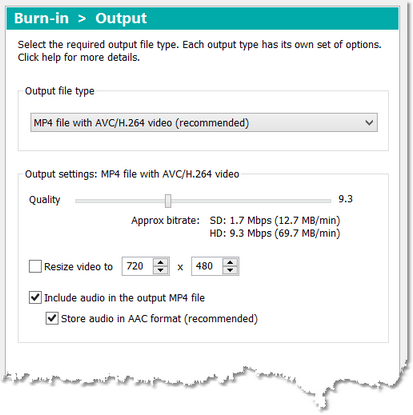
Output settings: MP4 file with AVC/H.264 video
The Output Settings: MP4 file with AVC/H.264 video panel allows you to adjust a set of options which apply only to the MP4 file with AVC/H.264 video output file type. This panel is only visible when you select this output file type.
This output file type is marked "recommended" for good reason. Burn-in usually progresses much faster because it uses the QuickSync video hardware acceleration that is built into most 2nd Generation (or greater) Intel processors. You can check whether your computer supports QuickSync video hardware acceleration on Intel's web site - for more details see the Hardware Acceleration topic.
Also, the combination of MP4 file container with AVC/H.264 video is supported by the vast majority of other video software, especially if you also select Store audio in AAC format.
Another advantage is that the AVC/H.264 encoder produces comparatively small burned-in files while maintaining visual quality, so these small files are more convenient for sending to colleagues or clients electronically or by copying onto media which has limited storage space - i.e. it is a good "delivery" format.
To keep things simple, we would recommend that you always use this output file type unless you have other specific requirements.
The Quality slider can be used to set the bitrate of the AVC/H.264 video encoder. Higher values usually provide better image quality at the expense of larger files. The corresponding approximate bitrates in megabits per second for standard and high definition video (SD and HD) are displayed beneath the slider as you drag it. The bitrates are also displayed in megabytes per minute which can be more helpful in estimating the final file size (though audio will add to this unless you want a silent output file).
You can also choose to resize the video while it is encoded. This can be useful if for example you wish to produce a low resolution video file for playback on your PC. Check the Resize video to option and set the required width and height in pixels (must be an exact multiple of 32). The whole video frame will be resampled to this new size while preserving the display aspect ratio.
If you check the Include audio stream in output MP4 file box, the output MP4 file will also contain the audio stream as well as the burnt-in video. We recommend that you also check the Store audio in AAC format, because AAC audio in MP4 files is more compatible for importing into other software - if you uncheck it then DVMP Pro will attempt to store the audio in the same format as the input file but this may not be well supported by other software.
If you leave the Include audio stream in output MP4 file box unchecked, the output file will contain only the burnt-in video with no audio stream (i.e. silent).
Output Settings: MP4 file with MPEG-2 video
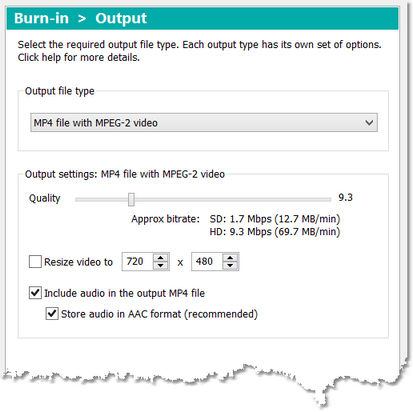
Output settings: MP4 file with MPEG-2 video
The Output Settings: MP4 file with MPEG-2 video panel allows you to adjust a set of options which apply only to the MP4 file with MPEG-2 video output file type. This panel is only visible when you select this output file type.
Burn-in is speeded up by the QuickSync video hardware acceleration that is built into most 2nd Generation (or greater) Intel processors. You can check whether your computer supports QuickSync video hardware acceleration on Intel's web site - for more details see the Hardware Acceleration topic.
The combination of MP4 file container with MPEG-2 video is not well supported by some video software, so we recommend that you use instead MP4 file with AVC/H.264 video unless you have good reason not to.
The Quality slider can be used to set the bitrate of the MPEG-2 video encoder. Higher values usually provide better image quality at the expense of larger files. The corresponding approximate bitrates in megabits per second for standard and high definition video (SD and HD) are displayed beneath the slider as you drag it. The bitrates are also displayed in megabytes per minute which can be more helpful in estimating the final file size (though audio will add to this unless you want a silent output file).
You can also choose to resize the video while it is encoded. This can be useful if for example you wish to produce a low resolution video file for playback on your PC. Check the Resize video to option and set the required width and height in pixels (must be an exact multiple of 32). The whole video frame will be resampled to this new size while preserving the display aspect ratio.
If you check the Include audio stream in output MP4 file box, the output MP4 file will also contain the audio stream as well as the burnt-in video. We recommend that you also check the Store audio in AAC format, because AAC audio in MP4 files is more compatible for importing into other software - if you uncheck it then DVMP Pro will attempt to store the audio in the same format as the input file but this may not be well supported by other software.
If you leave the Include audio stream in output MP4 file box unchecked, the output file will contain only the burnt-in video with no audio stream (i.e. silent).
Output Settings: MP4 file with Cineform video
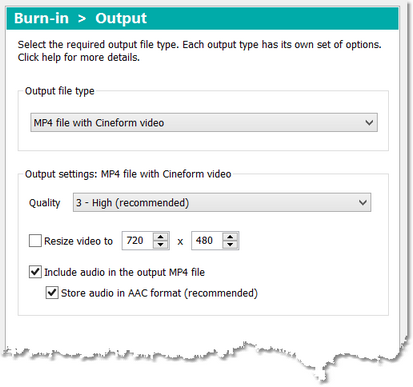
Output settings: MP4 file with Cineform video
The Output Settings: MP4 file with Cineform video panel allows you to adjust a set of options which apply only to the MP4 file with Cineform video output file type. This panel is only visible when you select this output file type.
The Cineform video compression format gives near-lossless quality, and the compression techniques it uses are so good that it can retain quality and make burn-in remarkably fast.
Being near-lossless, the size of the MP4 file with Cineform video burned-in files are much larger than the more compressed output file types such as MP4 file with AVC/H.264 video and MP4 file with MPEG-2 video.
Whether this output file type is suitable for you depends on how you intend to use your burned-in/time-stamped files.
Basically there a two broad usage categories of video file types - "Delivery" and "Intermediate".
Delivery formats are small and portable, and easily copied or "delivered" electronically to colleagues or clients. They are optimized for playback on low powered computers or devices, and take up little storage space. The output file type MP4 file with AVC/H.264 video is an example of an excellent delivery format - we recommend you use that if you are delivering your time-stamped files directly to other people.
Intermediate formats are intended to be imported into other software so that the video footage can be further edited, effects added, or converted/transcoded into another file type. Intermediate files are effectively an intermediate stage in processing your video. The software they are imported into is likely to be running on the same (or nearby) computer as DVMP Pro, so it is unlikely that the files will need to be copied anywhere else. The priority of intermediate formats is maintaining the very best quality to begin the next editing stage, so intermediate files will be much larger and hence less portable than delivery formats.
MP4 file with Cineform video is an example of an intermediate format. It is the ideal combination of speed, quality and relatively small file size (compared with other intermediate formats) that has made it one of the most popular intermediate formats in professional video production for many years. We recommend it if you need to do further editing or conversion of burned-in/time-stamped video files, and you have plenty of hard drive space available.
Most mainstream video editing software should be able to import and work with files that have the Cineform video format, but for some you may have to install the Cineform decoders package which can be downloaded from the official Cineform web site: https://cineform.com/gopro-cineform-decoder (do not download it from anywhere else). Alternatively, the Cineform decoders also come bundled with GoPro's "Quik Desktop" software. These decoders can then be utilized by video editing software that does not have its own built-in support for Cineform.
Before you decide to make regular use of MP4 file with Cineform video make sure that the other video software that you will be using is able to open or import the burned-in files (install the Cineform decoders if necessary).
To help with compatibility, you can instead choose AVI file with Cineform video. This is the same as MP4 file with Cineform video except that the file container is AVI instead of MP4. Some software may provide better support for AVI files than MP4 files, so if you experience problems importing one of these formats into other software, you can try importing the other format instead.
In the output settings panel, the Quality control can be used to set the video quality from 1 to 5. Higher values will produce larger files. We recommend that you leave this set to "3 - High". Apparently "4 - FilmScan1" was introduced for specialized scanning of material from film, so you are unlikely to notice any improvement over 3. And "5 -FilmScan2" is sometimes referred to as "overkill"!
You can also choose to resize the video while it is encoded. This can be useful if you wish to produce a lower resolution video file. Check the Resize video to option and set the required width and height in pixels (must be an exact multiple of 32). The whole video frame will be resampled to this new size while preserving the display aspect ratio.
If you check the Include audio stream in output MP4 file box, the output MP4 file will also contain the audio stream as well as the burnt-in video. We recommend that you also check the Store audio in AAC format, because AAC audio in MP4 files is more compatible for importing into other software - if you uncheck it then DVMP Pro will attempt to store the audio in the same format as the input file but this may not be well supported by other software.
If you leave the Include audio stream in output MP4 file box unchecked, the output file will contain only the burnt-in video with no audio stream (i.e. silent).
Output Settings: AVI file with Cineform video
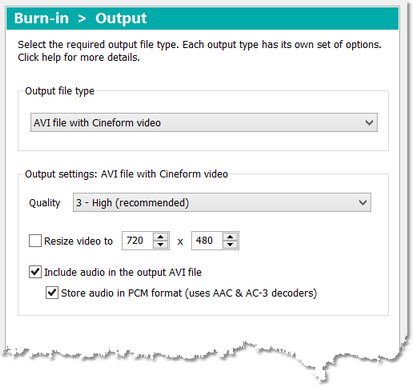
Output settings: AVI file with Cineform video
The Output Settings: AVI file with Cineform video panel allows you to adjust a set of options which apply only to the AVI file with Cineform video output file type. This panel is only visible when you select this output file type.
This output file type is exactly the same as MP4 file with Cineform video except that the file container is AVI instead of MP4. Some software may find it easier to open/import files that contain Cineform video in an AVI container than an MP4 container.
See the MP4 file with Cineform video section above for a full explanation of this output type.
There are two settings that allow you to choose the format of the audio in the output file (or have a silent file). For details of how these work, see the AVI Audio Settings section below.
Output Settings: WMV file with VC-1 video
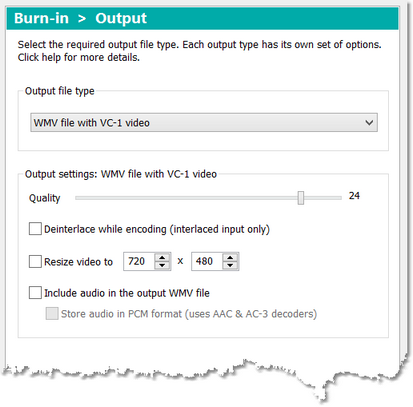
Output settings: WMV file with VC-1 video
The Output Settings: WMV file with VC-1 video panel allows you to adjust a set of options which apply only to the WMV file with VC-1 video output file type. This panel is only visible when you select this output file type.
You can adjust the Quality setting used by the VC-1 encoder (which uses VBR mode). There are 29 levels of quality (0-28) chosen by moving the slider. Higher values will produce visually better quality video, but will also produce larger files.
If your source video is interlaced and you check Deinterlace while encoding, then the VC-1 encoder will deinterlace your video as it is encoded. This results in a progressive output WMV file. This setting has no effect if the source video is already progressive.
Note that the VC-1 encoder processes progressive video faster than interlaced; so if your source video is interlaced, and you are happy for it to be deinterlaced and encoded as a progressive WMV file, then the file will be encoded faster if you check Deinterlace while encoding.
You can also choose to resize the video while it is encoded. This can be useful if for example you wish to produce a low resolution video file for playback on your PC. Check the Resize video to option and set the required width and height in pixels. The whole video frame will be resampled to this new size while preserving the display aspect ratio.
If you check the Include audio stream in output WMV file box, the output WMV file will also contain the audio stream as well as the burnt-in video. For HDV input files the audio stream will be stereo LPCM, and for AVCHD it will be the same multi-channel AC-3 audio as in the input m2ts/mts file. For MPEG-2 PS input files the audio stream will be either LPCM or AC-3 depending on the audio type of the input file - this also applies to Sony's NXCAM variant of AVCHD which may have either LPCM or AC-3 audio. If you leave this option unchecked, the output file will contain only the burnt-in video with no audio stream (i.e. silent).
Please note that Windows Media Player 11 (or later) may have problems playing WMV files that contain AC-3 audio. This is because from version 11 WMP uses "Media Foundation" (instead of "DirectShow") to play WMV files which is more restricted and is unable to use the DirectShow AC-3 decoder. Therefore, if you encounter problems playing the WMV file in Windows Media Player (or importing into Windows Movie Maker) then you can either select the Store audio in PCM format (uses AAC & AC-3 decoders) option that converts the audio to the PCM format which is more compatible, or you can use an alternative media player such as "Media Player Classic Home Cinema" or "VLC".
If you check the Store audio in PCM format (uses AAC & AC-3 decoders) box, then if the input file's audio format is AAC or AC-3 it will be passed through the AAC or AC-3 Audio Decoder which is set in DVMP Pro's Audio Decoders options page. This decodes the AAC or AC-3 audio and stores it as PCM in the WMV file. If the input file's audio format is not AAC or AC-3 then this option has no effect. See below for more details about this checkbox and multi-channel audio.
Output Settings: AVI file
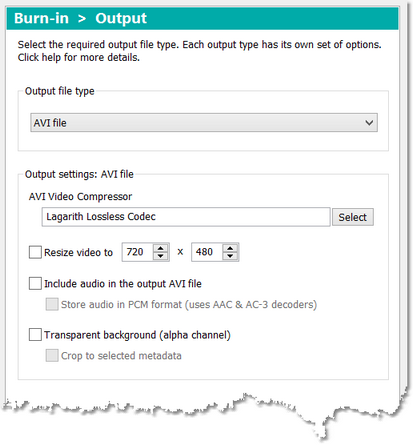
Output settings: AVI file
Here you can adjust a set of burn-in/time-stamp options which apply only to the AVI file output file type. These are only visible when you select AVI file.
You can select the AVI Video Compressor that is used when burning-in metadata and time-stamping HDV, AVCHD, MOV, MP4 or MPEG-2 PS files (ignore this setting if you are burning-in DV file types).
As each frame is burned-in it is passed through the video compressor and stored in the output AVI file. For more details see the How Burn-in Works chapter.
If you click the Select button, a Select AVI Video Compressor dialog box appears which presents you with a list of third-party video compressors that are currently installed on your PC. DVMP Pro creates this list by examining the properties of the installed video compressors and making an assessment of which are likely to be able to handle high resolution video frames and store them in an AVI file. Compressors which fail this assessment are not listed. See further details of recommended AVI Video Compressors.
The name of each compressor in the list is followed by its fourcc code (if available) in square brackets. This describes the compression scheme used by the compressor. Some compressors are supplied with a utility which can be used to change their compression scheme - in this case the displayed fourcc code is the compressor's setting at the time the Select button was pressed. If this all sounds too technical or confusing, just ignore this paragraph - in most cases you won't need to be concerned with this level of detail.
Some compressors have a built-in "property sheet" which contains settings that allow you to change the compressor's internal behavior (such as its compression ratio). If the selected compressor has such a property sheet then the Properties button is enabled - you simply click the Properties button to view the compressor's property sheet. You can then view the current settings or change them and click its OK button to save your changes.
|
WARNING: Some settings may prevent DVMP Pro from processing files correctly, so do not make any changes to the compressor properties unless you are confident you know what you are doing - at the very least make a note of the settings before you attempt to change any of them, so that you can change them back again if you encounter any problems. |
Some compressors store a separate list of property settings for each application that they are used in, so you may find that changing settings in DVMP Pro does not change the settings for the same compressor when used in other applications.
The displayed list of compressors contains both lossless and lossy compressors, so you can select whichever type of compression you prefer from the list. You can also select "Uncompressed" but beware that this will use a lot of disk space. Then click OK to submit your selection.
You can also choose to resize the video while it is encoded. This can be useful if for example you wish to produce a low resolution video file for playback on your PC. Check the Resize video to option and set the required width and height in pixels. The whole video frame will be resampled to this new size while preserving the display aspect ratio.
AVI Audio Settings
 If you check the Include audio stream in output AVI file box, the output AVI file will also contain the audio stream as well as the burnt-in video. For HDV input files the audio stream will be stereo LPCM, and for AVCHD it will be the same multi-channel AC-3 audio as in the input m2ts/mts file. For MPEG-2 PS input files the audio stream will be either LPCM or AC-3 depending on the audio type of the input file - this also applies to Sony's NXCAM variant of AVCHD which may have either LPCM or AC-3 audio. If you leave this option unchecked, the output file will contain only the burnt-in video with no audio stream - i.e. the file will be silent.
If you check the Include audio stream in output AVI file box, the output AVI file will also contain the audio stream as well as the burnt-in video. For HDV input files the audio stream will be stereo LPCM, and for AVCHD it will be the same multi-channel AC-3 audio as in the input m2ts/mts file. For MPEG-2 PS input files the audio stream will be either LPCM or AC-3 depending on the audio type of the input file - this also applies to Sony's NXCAM variant of AVCHD which may have either LPCM or AC-3 audio. If you leave this option unchecked, the output file will contain only the burnt-in video with no audio stream - i.e. the file will be silent.
Please note that some video editing software and utilities may not support the AC-3 audio format within AVI files, or may have incomplete support for it. If you have checked the Include audio stream in output AVI file and find that the resulting burned-in AVI file can not be read by your video editing software (or it behaves erratically when playing or processing the file), then look at the input file's audio properties in DVMP Pro (File > Properties menu) - if the audio format is AC-3 then check the Store audio in PCM format (uses AAC & AC-3 decoders) box (see below) and try the burn-in again.
If you check the Store audio in PCM format (uses AAC & AC-3 decoders) box, then if the input file's audio format is AAC or AC-3 it will be passed through the AAC or AC-3 Audio Decoder which is set in the Tools > Options > Audio Decoders menu. This decodes the AAC or AC-3 audio and stores it as PCM in the AVI file. If the input file's audio format is not AAC or AC-3 then this option has no effect. This option can be useful if other programs have no (or incomplete) support for AAC or AC-3 audio stored in AVI files - the PCM audio format is compatible with most programs.
If you have "LAV Audio Decoder" or "AC3Filter" selected as the AC-3 Audio Decoder, then you can choose to have multi-channel AC-3 audio stored as corresponding multi-channel PCM. Alternatively, if you find that your video editing program does not support multi-channel PCM in AVI files, then you can choose to have it stored as 2 channel stereo PCM instead. You make this choice by setting the properties of the LAV Audio Decoder or AC3Filter. Go to Tools > Options > Audio Decoders, click the AC-3 Audio Decoder's Select button, then in the "Select AC-3 Audio Decoder" box choose "LAV Audio Decoder" or "AC3Filter" and then click the Properties button. Now set the properties as shown below - other properties not shown will also affect the output audio so you will probably want to ensure these are set to default values before you perform a burn-in.
PCM channels |
LAV Audio Decoder |
AC3Filter |
|---|---|---|
Multi-Channel |
 On the Mixing tab, un-check "Enable Mixing" |
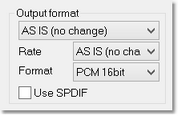 Set Output Format and Sampling Rate to "AS IS" |
2 Channel Stereo |
 On the Mixing tab, check "Enable Mixing" and set output configuration to "Stereo" |
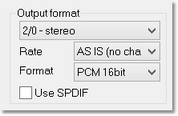 Set Output Format to "2/0 - stereo" |
See Options - Audio Decoders for further details of audio decoders and how to select them.
AVI Alpha Transparency
 If you check the Transparent background (alpha channel) box, the output AVI file will contain the metadata text written over a uniform transparent background (instead of written over the input video frames). You may find this useful in video editing programs which correctly support alpha channel/transparency in imported files. You can then import both the original video file and the transparent-background AVI file onto separate tracks, line them up, and the original video track will show through the transparent area - the metadata text will then appear to be written across (and correctly anti-aliased against) the original video track. You could then apply whatever effects/fades you want to the metadata text.
If you check the Transparent background (alpha channel) box, the output AVI file will contain the metadata text written over a uniform transparent background (instead of written over the input video frames). You may find this useful in video editing programs which correctly support alpha channel/transparency in imported files. You can then import both the original video file and the transparent-background AVI file onto separate tracks, line them up, and the original video track will show through the transparent area - the metadata text will then appear to be written across (and correctly anti-aliased against) the original video track. You could then apply whatever effects/fades you want to the metadata text.
A burn-in using the Transparent background option will usually proceed faster than a "regular" burn-in because the original video frames do not need to be decoded, but you can make it even faster by also checking the Crop to selected metadata box. This produces much smaller frames in the output AVI file because they are cropped closely around the text of the metadata items that you selected. Because this omits large areas of uniform transparent background, the output AVI file size is usually much smaller and the burn-in proceeds much faster. As these cropped frames have a smaller width or height than the original video frames, you may have to adjust the position of the text on the video editor's track. Note that the Crop to selected metadata option can only be used with the Transparent background (alpha channel) option.
 For the transparent background option to work correctly it requires an AVI Video Compressor in DVMP Pro and a video editing program which both correctly support alpha channel transparency. The only well-known compressor which correctly supports the alpha channel is Lagarith, and you must specifically switch on its alpha channel support by setting the "Mode" in its Properties to "RGBA". If you select a compressor which does not support the alpha channel (or its support is switched off) then the resulting burnt-in AVI file will just contain the metadata text over an opaque black background. You can then only be sure that a transparent burn-in has succeeded by importing the burnt-in AVI file into a video editor or other program which correctly supports alpha channel transparency. Some video editing software can also recognize alpha channel transparency in "Uncompressed" AVI output files.
For the transparent background option to work correctly it requires an AVI Video Compressor in DVMP Pro and a video editing program which both correctly support alpha channel transparency. The only well-known compressor which correctly supports the alpha channel is Lagarith, and you must specifically switch on its alpha channel support by setting the "Mode" in its Properties to "RGBA". If you select a compressor which does not support the alpha channel (or its support is switched off) then the resulting burnt-in AVI file will just contain the metadata text over an opaque black background. You can then only be sure that a transparent burn-in has succeeded by importing the burnt-in AVI file into a video editor or other program which correctly supports alpha channel transparency. Some video editing software can also recognize alpha channel transparency in "Uncompressed" AVI output files.
Please note that currently Adobe Premiere Pro and Elements ignores the alpha channel transparency if you had checked the Include audio stream in output AVI file box and the input file's audio format is AC-3 (nearly always the case with AVCHD files). The inclusion of an AC-3 audio stream seems to make Premiere ignore the alpha channel. This may be a bug in Premiere, but if you encounter this problem, you can check the Store audio in PCM format (uses AAC & AC-3 decoders) box which will cause the audio to be stored in the AVI file in PCM format instead of AC-3 format - the alpha channel should now be recognized correctly by Premiere. See above for more details of the Store audio in PCM format (uses AAC & AC-3 decoders) option.
Output Settings: MPG file with MPEG-2 video
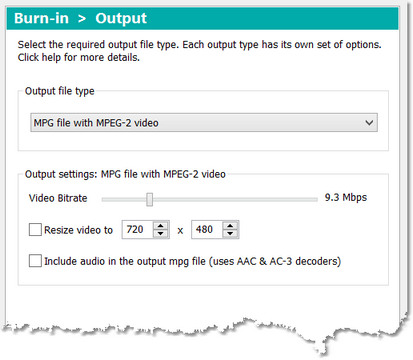
Output settings: MPG file with MPEG-2 video
The Output Settings: MPG file with MPEG-2 video panel allows you to adjust a set of options which apply only to the MPG file with MPEG-2 video output file type. This panel is only visible when you select this output file type.
Note that this output file type is only available if you are using Windows 7. It is also available if you are using Windows 8 or 8.1 but only if you also had installed the Microsoft "Windows Media Center" feature pack which used to be available from Microsoft as an add-on for Windows 8/8.1. It is not available in Windows 10 because the underlying encoder has been removed completely by Microsoft - you may want to bear this in mind if you are considering upgrading to Windows 10 (upgrading will remove it).
The output file is an MPEG-2 Program Stream with the video stream encoded in the MPEG-2 video compression scheme. The filename extension is .mpg.
You can adjust the Video bitrate setting used by the MPEG-2 encoder up to a maximum of 40 Mbps (megabits per second). Higher values will produce visually better quality video, but will also produce larger files.
You can also choose to resize the video while it is encoded. This can be useful if for example you wish to produce a low resolution video file for playback on your PC. Check the Resize video to option and set the required width and height in pixels. The whole video frame will be resampled to this new size while preserving the display aspect ratio.
If you check the Include audio stream in output mpg file box, the output .mpg file will also contain the audio stream as well as the burned-in video. If you leave this option unchecked, the output file will contain only the burnt-in video with no audio stream (i.e. silent).
Output Settings: MPG file with MPEG-2 video (DVD specs)
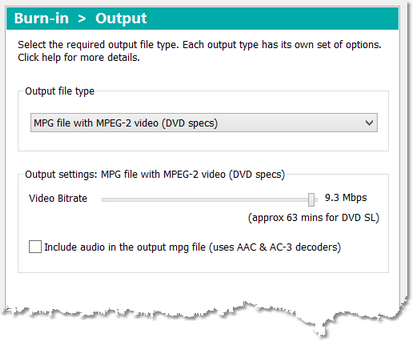
Output settings: MPG file with MPEG-2 video (DVD specs)
The Output Settings: MPG file with MPEG-2 video (DVD specs) panel allows you to adjust a set of options which apply only to the MPG file with MPEG-2 video (DVD specs) output file type. This panel is only visible when you select this output file type.
Note that this output file type is only available if you are using Windows 7. It is also available if you are using Windows 8 or 8.1 but only if you also had installed the Microsoft "Windows Media Center" feature pack which used to be available from Microsoft as an add-on for Windows 8/8.1. It is not available in Windows 10 because the underlying encoder has been removed completely by Microsoft - you may want to bear this in mind if you are considering upgrading to Windows 10 (upgrading will remove it).
Like the MPG file with MPEG-2 video output type, the MPG file with MPEG-2 video (DVD specs) output file is an MPEG-2 Program Stream with the video stream encoded in the MPEG-2 video compression scheme. However, MPG file with MPEG-2 video (DVD specs) has additional constraints to make the output file comply more closely with the video DVD specification (e.g. standard definition, PAL/NTSC frame rate, etc). The filename extension is .mpg.
|
IMPORTANT: Remember that DVMP Pro does not create DVD video disks - it produces the burnt-in video files that you can then import into your own separate DVD authoring software (or video editing software). It is the DVD authoring software that actually compiles and creates a DVD disk. |
In theory, it should be quicker to use MPG file with MPEG-2 video (DVD specs) output files in DVD authoring software because they are already in a suitable compressed format for video DVDs. But unfortunately, in practice, a lot of DVD authoring software insists on always re-compressing (i.e. decompressing then compressing again) all video files when it makes a DVD, even if the files are already DVD compliant. Consequently, if your DVD authoring software always re-compresses video files, then there is little point in using MPG file with MPEG-2 video (DVD specs) as the output type when other output types may be ultimately faster to burn-in.
You can adjust the Video bitrate setting used by the MPEG-2 encoder up to a maximum of 9.4 Mbps (megabits per second). Higher values will produce visually better quality video, but will also produce larger files. As a rough guide, the approximate maximum playback duration for the chosen bitrate on a single-layer DVD disk is displayed beneath the slider.
If you check the Include audio stream in output mpg file box, the output .mpg file will also contain the audio stream as well as the burned-in video. If you leave this option unchecked, the output file will contain only the burnt-in video with no audio stream (i.e. silent).
See Also:
How Burn-in Works
Delivery and Intermediate File Types

